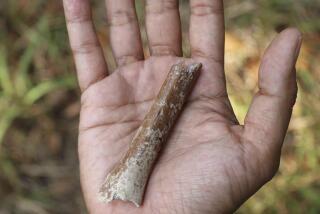New fossil find reveals tiny hedgehog the size of your thumb
Researchers in British Columbia have unearthed a 52 million year old fossil of the smallest hedgehog known to science.
The animal was fully grown when it died, and just two inches long -- about the length of your thumb. The research team named it Silvacola acares, which means âtiny forest dweller.â
This little guy was so eensy-weensy that that his back molars were just 1 millimeter in length. His bones were so delicate that the researchers were worried his fossil would break apart if they tried to get it out of the rock.
Instead, they decided to leave the fossilized parts of the animalâs skull embedded in the rock and do a micro-CT scan on it to figure out exactly what mammal they were looking at.
âI compared the scan of his molars to hundreds of little, tiny teeth,â said Jaelyn Eberle, who studies ancient mammals at the University of Colorado at Boulder. âBut before too long I realized there isnât anything that looks exactly like this guyâs teeth.â
Finally she realized she had not just a new species, but a new genus on her hands. Eberle is the lead author of a paper describing the hedgehog, as well as a tapir-like animal that was also the found at the site, that was published Tuesday in the Journal of Vertebrate Paleontology.
Unfortunately, we can only get to know this mini-hedgehog through fossils. Silvacola acares lived during the early Eocene era, when the Earth was the warmest it has been since the time of the dinosaurs.
At that time, this part of British Columbia was covered by an unusual rain forest where palm trees and spruce trees stood side by side. The average temperature was probably somewhere in the mid-50s Fahrenheit. The palm trees suggest that it never got below freezing.
Eberle said the tiny hedgehog was an omnivore that probably ate insects and plants it found on the forest floor.
The Silvacola fossil was discovered in the Driftwood Creek Beds near Smithers, B.C., about 420 miles north of Vancouver. It was once the site of an ancient lake, and it is a popular place to find fossils of early Eocene era plants and insects, but the hedgehog and the tapir relative were the first mammal fossils discovered at the site.
Eberle thinks there are almost certainly more fossilized remains of mammals hidden in the rocks.
âIt just wasnât on anyoneâs radar for fossil mammals, so when they found them, they were rather shocked,â she said. âI think there are more to be found; we just have to go look.â
For more amazing (and cute!) science news, follow me @DeborahNetburn






